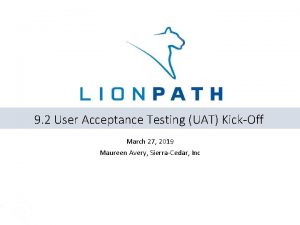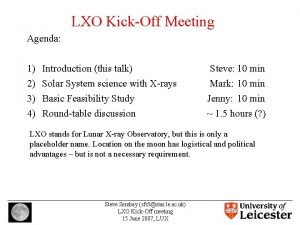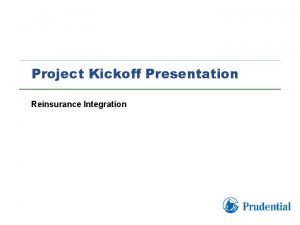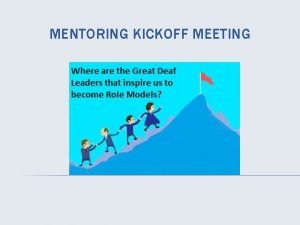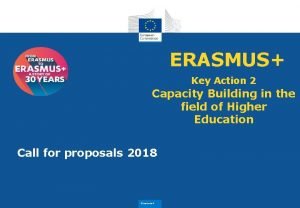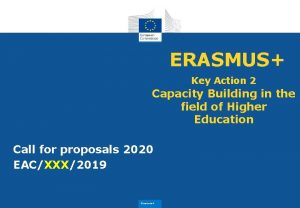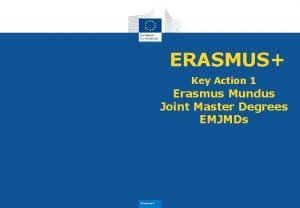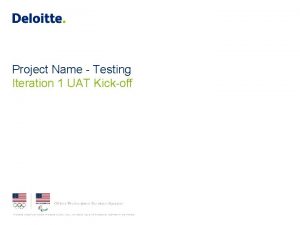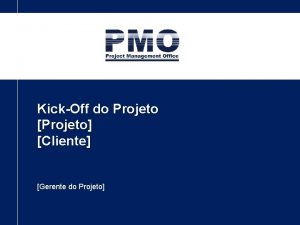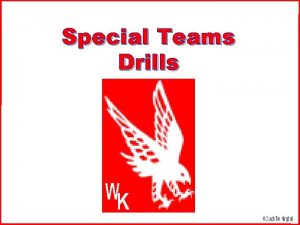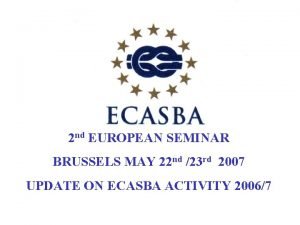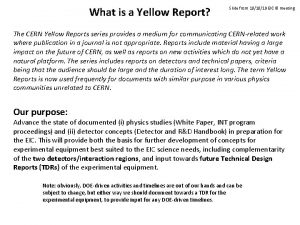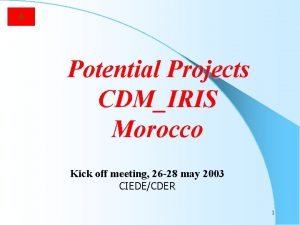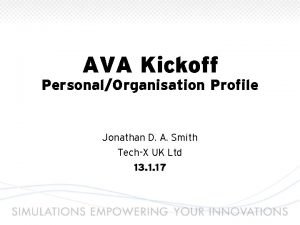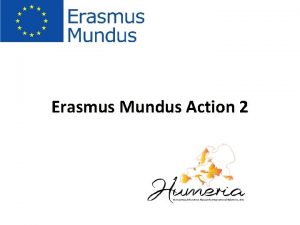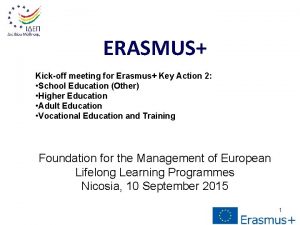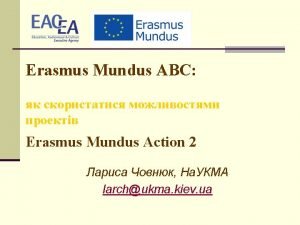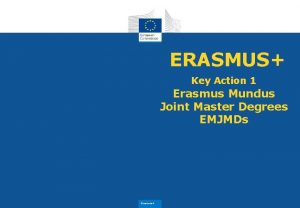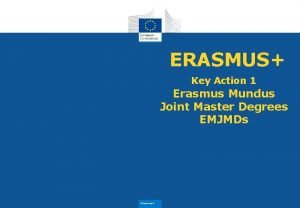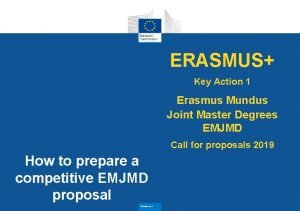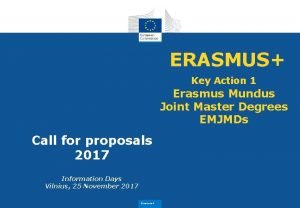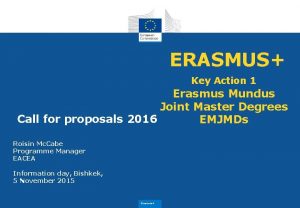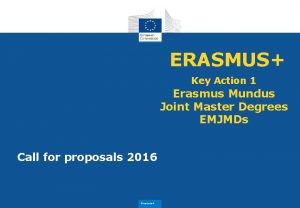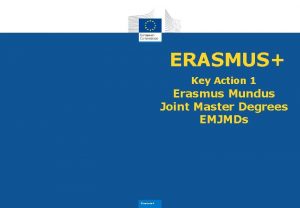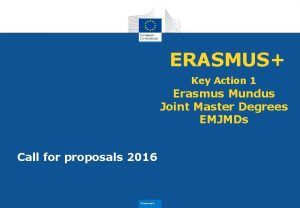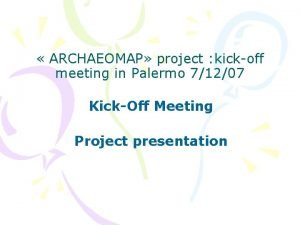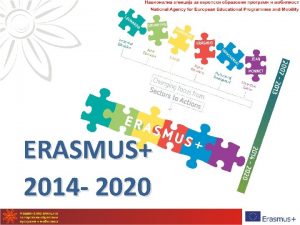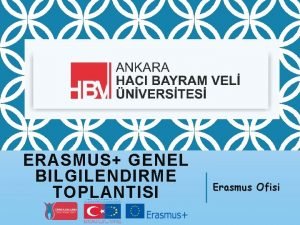ERASMUS Kickoff meeting for Erasmus Key Action 2

























































- Slides: 57

ERASMUS+ Kick-off meeting for Erasmus+ Key Action 2: • School Education (Other) • Higher Education • Adult Education • Vocational Education and Training Foundation for the Management of European Lifelong Learning Programmes Nicosia, 25 September 2014 1

Agreement • Grant agreement is signed between the NA and the Coordinator (original is to be kept at the institution for 5 years) • All communication takes place between the National Agency (NA) and the coordinator. 2

Annexes • • Annex Ι: Description of the project Annex ΙΙ: Estimated budget Annex ΙΙΙ: Financial and contractual rules Annex ΙV: Templates for agreement documents to be used between beneficiaries and participants [if applicable] • Annex V: Mandate(s) provided to the coordinator by the other beneficiary[ies] • Annex VI: List of other beneficiaries 3

Project duration • Project duration: 2 or 3 years • Start date: 01. 09. 2014 • End date: 31. 08. 16 or 31. 08. 17 For 2 -year projects, extension of 6 months is possible in exceptional cases. No further funding can be given for that period and the extension should be the result of a formal request for an amendment of the grant agreement. 4

Role of the coordinator (1/2) • Monitors that the project is implemented in accordance with the Agreement • Intermediary for all communications with the NA • Makes arrangements for providing all financial guarantees required under the Agreement 5

Role of the coordinator (2/2) • Establishes the requests for payment • Ensures that all appropriate payments are made to the other beneficiaries without any delay • Is responsible for providing all the necessary documents in the event of checks 6

Role of partners (1/3) • Responsible for carrying out the Project in accordance with the terms and conditions of the Agreement • Responsible for complying with any legal obligations jointly or individually • Make appropriate internal arrangements for the proper implementation of the Project consistent with the provisions of the Agreement 7

Role of partners (2/3) • Inform the coordinator immediately of any change likely to affect or delay the implementation of the Project • Inform the coordinator immediately of any change in their legal, financial, technical, organisational or ownership situation and of any change in their name, address or legal representative 8

Role of partners (3/3) • Submit in due time to the coordinator – Data for reports, financial statements and other documents provided for in the Agreement – All the documents in the event of audits, checks, evaluation and monitoring – Any other information to be provided to the NA according to the Agreement 9

Agreements between coordinator and partners • Only the mandate is required • However, internal arrangements between the partners (contractual agreements) are highly recommended and are considered good practice for the smooth realisation of the project. 10

Mandates • The NA can accept the scanned copy of the duly signed mandate. • The coordinator keeps the originals as part of the supporting documents for the project for possible checks by the NA and other bodies for 5 years. 11

First pre-financing • It is intended to provide beneficiaries with cash flow. • When: 30 days following the entry into force of the Agreement (provided that no financial guarantee is pending and financial capacity of the organisation has been checked). 12

Further pre-financing • Following the interim report with proof that the 70% of the first pre-financing has been spent. 13

Balance payment • Upon evaluation of the FR, the NA shall proceed with the last instalment if applicable. • There can be a grant reduction for poor, partial or late implementation of the Project on the basis of the FR submitted by the coordinator, the products and outputs produced and if applicable, reports from individuals taking place in Transnational learning/teaching/training activities or on the basis of other sources e. g. monitoring visits, desk checks or on the spot checks 14

Payments (as described in the Agreement) % Requirement When Pre-financing 40 Sign the agreement No later than 30 days after signing the agreement Further 40 pre-financing Interim report submission 2 & 3 year projects Submission deadline: 30. 04. 15 Reporting period: up to 15. 03. 2015 Final payment Final report submission 2 -year projects Submission deadline 30. 16 Reporting period: up to 31. 08. 16 20 3 -year projects Submission deadline 30. 17 Reporting period: up to 31. 08. 17 15

Bank Account Payments will be made to the account provided in the URF database. Should a different account be requested for different projects, that should be noted in the Remarks Section of the Financial Identification Document uploaded in the URF database or notified to us via email. 16

identification 17

For CY Coordinators • For schools, evening schools/second chance schools instalments will be made to the School Boards • For Ministries, or other governmental bodies, Technical Schools, State Institutes for Further Education, Adult Education Centres, Adults Special Schools instalments will be made to the Central Bank Account – Κεντρικός Κυβερνητικός Λογαριασμός • For all other private organisations, instalments will be made to the bank account of the organisation 18

Budget Headings • • Project management and implementation Transnational project meetings Intellectual outputs Multiplier events Learning/teaching/training activities Special needs Exceptional costs All eligible costs are unit costs apart from Special Needs and Exceptional Costs 19

Project management and implementation • Unit Cost (amount per month) • In order for the beneficiaries to be given this amount in total, they have to implement the activities and produce the outputs as applied for in the grant application • Proof: Final Report / Dissemination platform / available for checks and audits 20

Project management and implementation What can be covered under this budget heading: - Planning, finances, coordination and communication between partners etc. - Small scale learning/teaching/training materials, tools, approaches etc. - Information, promotion, dissemination (brochures, flyers, leaflets, web information) - Participants insurance 21

Transnational project meetings • Transnational meetings are hosted only by one of the participating organisations. • In all cases, the beneficiaries have to be able to demonstrate a formal link with the persons participating in the transnational project meetings (staff or learners of the organisation) 22

Transnational project meetings • Allocated on the basis of the online distance band calculator. • Αll travel and subsistence costs are included, regardless of the duration of the meeting • Participations shall be reported in the Mobility Tool by the coordinator (name of participant / place of origin and venue / distance band) 23

Transnational Project Meetings within the same country Participation in Transnational project meetings taking place within the same country are eligible only if: • the activities involve participants from Project beneficiary organisations from at least two different Programme Countries • the distance between the place of departure and place of arrival is at least 100 km following the online distance calculator. 24

Supporting documents for Project Meetings • Certificate of participation issued and signed by the host institution specifying: – the name of the participant – the purpose of the activity abroad – starting and end date 25

Transnational Project meeting Organisation • Agenda (prepared in cooperation with all partners in advance) – planning, coordination, evaluation, preparation, dissemination • Invitation and Programme sent in advance • Certificate of participation • Accommodation of partners • Participation of relevant stakeholders if applicable • Cultural aspect of the meeting 26

Intellectual Outputs (IOs) • The beneficiaries shall develop the IOs approved by the CY NA. • The coordinator shall report on the activities undertaken and results produced in the Mobility Tool on behalf of all the project partners. • The coordinator shall provide evidence of the project results which shall be uploaded at final report stage on the dissemination platform. 27

Intellectual Outputs • Number of days of work person shall be reported in the Mobility Tool on the basis of timesheets (days x unit per day – according to staff category and country). • Only members of the staff can work for the development of intellectual outputs Note: staff categories “manager” and “administrative staff” can be used only if applied for and approved by the CY NA. 28

Supporting documents for IOs • Proof that the IO has been realised and it is of acceptable quality (dissemination platform and available for checks and audits) • Time sheets person (name, category of staff, dates, total number of days) signed by both the employees and the employer (legal representative). 29

Supporting documents for IOs • Proof of relationship between the person and beneficiary organisation as registered in the official records of the beneficiary: – employment agreement/contract between employer and employee – Payslips – Voluntary work etc 30

Multiplier events • Multiplier events are eligible only if approved for by the CY NA. • In case the beneficiaries do not develop the IOs approved by the NA then the related Multiplier Events will not be eligible for grant support. • If the NA awarded support for the development of several IOs but only some are realised, the NA will determine to which extent the related Multiplier event is eligible. 31

Multiplier events • Only participants from organisations other than the beneficiaries can be counted in for the number of persons on the basis of which the grant amount is established. • Multiplier events take place only in the Programme Countries in which the beneficiaries are located. 32

Supporting documents for Multiplier events • Proof that the event has taken place and is of acceptable quality - description in the final report • Invitation to and programme of the event • Detailed agenda of the event and any documents used or distributed at the event 33

Supporting documents for Multiplier events • Signed attendance list with name, date and place of the event and for each participant: • • Name Email address Signature of the participant Name and address of the sending organisation of the person 34

Learning/teaching/training activities • The eligible minimum duration of mobility activities is the minimum duration of the activity excluding travel. • One day for travel directly before the first day of the activity abroad and one day of travel directly following the last day of the activity abroad can be added; these days will be counted in for the calculation of the individual support. 35

Learning/teaching/training activities • Participation of persons in these activities taking place in their own country is eligible for funding under this budget category, provided that the activities involve participants from beneficiary organisations from at least two different Programme Countries and that the distance is at least 100 km following the online distance band calculator. 36

Learning/teaching/training activities • Who can participate? Persons who have a direct link with a beneficiary organisation in one of the following capacities: - Students of HEI - Apprentices, VET students, adult learners - Pupils of any age accompanied by school staff - Pupils over 14 enrolled in full-time education for long -term mobility of pupils - Professors, teachers, trainers and educational administrative staff employed at a participating organisation 37

Learning/teaching/training activities • The coordinator records all activities in the MT • The MT will calculate the grant amounts for travel and individual support based on unit cost rates. • Participants in these activities shall report on this activity via an on-line questionnaire providing their feedback in terms of factual information and their appreciation of the activity period abroad, as well as of its preparation and follow-up. 38

Incoherence between Programme Guide and Grant Agreement • Even if applicants applied only for the exact number of days per planned activity, beneficiaries can add an extra day for travel before and after the mobility activity. • These days are eligible for the calculation of the individual support. • If this extra day(s) is/are added, the actual duration of the activity has to be clear • The NA cannot increase the final grant amount over and above the awarded amount. 39

Supporting documents for Learning/teaching/training activities • Copy of the certificate of participation in the activity issued and signed by the receiving organisation which specifies: – the name of the participant – the purpose of the activity abroad – starting and end date 40

Special needs • Allocated on the basis of real costs. Includes all costs and all means of travel from the point of origin to the point of destination (including travel from/to the airport to/from the hotel) or any other cost apart from travelling for participants with special needs in any of the approved Project activities. • The coordinator shall report in the MT whether (additional) grant support for special needs was used 41

Supporting documents for Special Needs support • Reporting will be related with the type and cost for additional expenses. • All receipts related with additional expenses incurred showing the type and exact amount spent to cover for the needs of people with special needs participating in any of the approved activities of the Project. 42

Exceptional costs Only for the following • sub-contracting of goods • Sub-contracting of services • Bank costs for financial guarantee if required by the Agreement Any recourse to subcontracting which is not provided for in Annex I of the Agreement shall be communicated to the NA by the coordinator for approval 43

Exceptional costs • Sub-contracting of services: only services that cannot be provided by the beneficiaries for duly justified reasons • Equipment cannot include normal office equipment (PCs, laptops, printers, beamers etc. ) or equipment used by the beneficiaries for their normal activities. • Funds allocated for any budget category, except Special needs support, can be transferred to Exceptional costs to contribute to the costs of a financial guarantee if required by the NA even if no funds are allocated for Exceptional costs. 44

Exceptional costs • The coordinator shall report in the MT the type of expenses and actual costs incurred for the exceptional costs • The coordinator is required to provide all supporting documents at final report stage. • 75% of the costs incurred shall be covered by the NA if that does not exceed the amount granted for that reason in the Agreement. 45

Supporting documents for Exceptional Costs • Contractual agreement between the beneficiary and the organisation which is going to provide the service. - where a procurement of goods/works/ services is required, the beneficiaries shall award the contract to the tender offering best value for money or, as appropriate, to the tender offering the lowest price, avoiding any conflict of interest. • Invoice and receipt of payment for the services or purchases. 46

Checks and audits • The coordinator must keep all relevant documents to the project for at least 5 years after the completion of the agreement including proof of the amounts transferred to each beneficiary. (i. e. invoices, copies of cheque payments, timesheets, payslips, subcontracting agreements, boarding passes, copies of bank transfers to partners) • All financial reports need to be consistent 47 with the accounting records kept.

Budget transfers It is possible to adjust the estimated budget set out in Annex II, by transfers between the different budget categories (by a certain percentage). This adjustment is not considered an amendment of the agreement provided that some rules are presented. 48

Possible budget transfers Up to 20% of the funds allocated for: • Project management and implementation • Transational Project Meetings • Intellectual Outputs • Multiplier Events • Learning/teaching/training activities to any other category except • Project Management and Implementation 49 • Exceptional Costs

20% transfers 20% maximum increase or decrease is allowed provided that the following categories already exist in the Grant Agreement: • Transnational Project Meetings • Intellectual Outputs • Multiplier Events • Learning/teaching/training activities 50

Exception 1 For the following budget headings there can be decrease by 20% but there can be NO INCREASE: • Project Management and Implementation Costs • Exceptional Costs (Derogation: the beneficiaries are allowed to transfer funds allocated for any budget category except Special needs support to Exceptional costs in order to contribute to the costs of a financial guarantee in so far as required by the NA in Article I. 4. 1) 51

Exception 2 Special needs support Money can be transferred to that category even if no funds have been allocated to that category. In such a case the maximum increase of 20% of this budget category does not apply Transfers from Special needs support heading to other budget headings are not possible. 52

• In all other cases of a budget change an amendment request is necessary. • It is not possible to modify - the total budget granted - the percentage of EU contribution (i. e. 75% of eligible costs for Exceptional Costs) - the maxima set in the Programme Guide for each budget heading 53

Mobility Tool • The coordinator will use the Mobility Tool to: a)to record all information in relation to the mobility activities undertaken under the Project (even activities with a zero grant) b)complete and submit Interim and Final Reports 54

Online tools • Mobility Tool • Dissemination Platform • URF database 55

Miscellaneous • Check contact details (names, addresses, phone numbers , emails etc) in applications. If anything changes inform the NA accordingly in order to proceed to the necessary changes. • All updates shall be forwarded to the contact persons of the coordinating organisations. • Any change to the agreement shall be notified to the CY NA for approval first. Amendments have to be sent to the NA at least one month before the end of the 56 eligibility period of the project.

Miscellaneous Any communication or publication related to the project shall indicate that : • the Project has received funding from the EU and shall display the EU emblem • The project reflects only the author’s view and that the NA and EC are not responsible for the information it contains 57
 Today meeting or today's meeting
Today meeting or today's meeting Agenda for mentor meeting
Agenda for mentor meeting User acceptance testing template
User acceptance testing template Proposal kickoff meeting agenda
Proposal kickoff meeting agenda Gambar
Gambar Project kickoff presentation
Project kickoff presentation Circle k #45067
Circle k #45067 Erasmus key action 2
Erasmus key action 2 Key action 1 erasmus
Key action 1 erasmus Key action 2 erasmus
Key action 2 erasmus Erasmus key action 1
Erasmus key action 1 For todays meeting
For todays meeting What is meeting and types of meeting
What is meeting and types of meeting Types of meeting
Types of meeting Uat kick off meeting
Uat kick off meeting Kick off projeto
Kick off projeto Kickoff drills
Kickoff drills Fast kickoff training code
Fast kickoff training code Yellow report eic
Yellow report eic Kickoff projet
Kickoff projet Kickoff 168
Kickoff 168 Ava's kickoff
Ava's kickoff Erasmus mundus action 2
Erasmus mundus action 2 Erasmus mundus action 2
Erasmus mundus action 2 Erasmus mundus action 2
Erasmus mundus action 2 Erasmus +
Erasmus + Key partner business model canvas
Key partner business model canvas Contoh bisnis model canvas makanan pdf
Contoh bisnis model canvas makanan pdf Fspos vägledning för kontinuitetshantering
Fspos vägledning för kontinuitetshantering Typiska drag för en novell
Typiska drag för en novell Tack för att ni lyssnade bild
Tack för att ni lyssnade bild Ekologiskt fotavtryck
Ekologiskt fotavtryck Varför kallas perioden 1918-1939 för mellankrigstiden?
Varför kallas perioden 1918-1939 för mellankrigstiden? En lathund för arbete med kontinuitetshantering
En lathund för arbete med kontinuitetshantering Adressändring ideell förening
Adressändring ideell förening Tidbok yrkesförare
Tidbok yrkesförare Sura för anatom
Sura för anatom Förklara densitet för barn
Förklara densitet för barn Datorkunskap för nybörjare
Datorkunskap för nybörjare Tack för att ni lyssnade bild
Tack för att ni lyssnade bild Debattartikel mall
Debattartikel mall Delegerande ledarstil
Delegerande ledarstil Nyckelkompetenser för livslångt lärande
Nyckelkompetenser för livslångt lärande Påbyggnader för flakfordon
Påbyggnader för flakfordon Kraft per area
Kraft per area Offentlig förvaltning
Offentlig förvaltning Jag har nigit för nymånens skära text
Jag har nigit för nymånens skära text Presentera för publik crossboss
Presentera för publik crossboss Teckenspråk minoritetsspråk argument
Teckenspråk minoritetsspråk argument Vem räknas som jude
Vem räknas som jude Treserva lathund
Treserva lathund Epiteltyper
Epiteltyper Claes martinsson
Claes martinsson Cks
Cks Lågenergihus nyproduktion
Lågenergihus nyproduktion Bra mat för unga idrottare
Bra mat för unga idrottare Verktyg för automatisering av utbetalningar
Verktyg för automatisering av utbetalningar Rutin för avvikelsehantering
Rutin för avvikelsehantering


